Modeling the Maximum Magnetic Entropy Change of Doped Manganite Using a Grid Search-Based Extreme Learning Machine and Hybrid Gravitational Search-Based Support Vector Regression
Abstract
:1. Introduction
2. Mathematical Formulation of the Proposed Models
2.1. Description of the Support Vector Regression Algorithm
2.2. Physical Principles of the Gravitational Search Algorithm
2.3. Mathematical Background of the Extreme Learning Machine
3. Dataset Description and Computational Implementation of the Proposed Models
3.1. Dataset Description and Chemical Formula of the Doped Manganite that Can be Incorporated into the Developed Models
3.2. Computational Hybridization of the Gravitational Search and Support Vector Regression Algorithms
3.3. Computational Implementation of the Grid Search-Based Extreme Learning Machine
4. Results and Discussion
4.1. Searching for the Optimum Hyperparameters of the Developed Models
4.2. Generalization and Predictive Strength Comparison Between the SVR- and ELM-Based Models
4.3. Superiority of the Present Models as Compared to the Existing Models in the Literature
4.4. Investigating the Doping Effect of Fe on the Value of the MMEC of the Pr0.6Ca 0.1Sr 0.3Mn 1-xFexO3 Manganite Compound Using the Developed GSA-SVR-Crystal Model
4.5. Implementation of the Developed Model for Determining the Maximum Magnetic Entropy Change of Different Classes of Doped Manganite
5. Conclusions and Recommendations
Author Contributions
Funding
Acknowledgments
Conflicts of Interest
References
- Hamdi, R.; Tozri, A.; Dhahri, E.; Bessais, L. Magnetocaloric properties and Landau theory of Dy0.5(Sr1−xCax)0.5MnO3 (0≤ x≤0.3) manganites at cryogenic temperatures. Chem. Phys. Lett. 2017, 680, 94–100. [Google Scholar] [CrossRef]
- Sellami-Jmal, E.; Ezaami, A.; Cheikhrouhou-Koubaa, W.; Cheikhrouhou, A. Investigation on physical properties in lanthanum vacancy of La0.65Ca0.35MnO3 elaborated at high temperature. J. Magn. Magn. Mater. 2018, 465, 762–767. [Google Scholar] [CrossRef]
- Ayadi, F.; Ammar, S.; Nowak, S.; Cheikhrouhou-Koubaa, W.; Regaieg, Y.; Koubaa, M.; Monnier, J.; Sicard, L. Importance of the synthesis and sintering methods on the properties of manganite ceramics: The example of La 0.7 Ca 0.3 MnO 3. J. Alloys Compd. 2018, 759, 52–59. [Google Scholar] [CrossRef]
- Das, K.; Banik, S.; Das, I. Large magnetocaloric effect in geometrically frustrated polycrystalline ErMnO 3 compound at cryogenic temperature. Phys. B Condens. Matter 2018, 533, 46–49. [Google Scholar] [CrossRef]
- Guorui, X..; Wei, H.; Peiqi, C.; Xiaowei, W. Effect of Nd-substitution on the structural, magnetic and magnetocaloric properties of La0.67-xNdxCa0.13Ba0.2MnO3 manganites. J. Magn. Magn. Mater. 2019, 491, 133–142. [Google Scholar]
- Owolabi, T.O.; Akande, K.O.; Olatunji, S.O.; Aldhafferi, N.; Alqahtani, A. Support Vector Regression Ensemble for Effective Modeling of Magnetic Ordering Temperature of Doped Manganite in Magnetic Refrigeration. J. Low Temp. Phys. 2019, 195, 179–201. [Google Scholar] [CrossRef]
- Linh, D.C.; Ha, N.T.; Duc, N.H.; Nam, L.H.G.; Bau, L.V.; An, N.M.; Yu, S.-C.; Tran, D.T. Na-doped La 0.7 Ca 0.3 MnO 3 compounds exhibiting a large magnetocaloric effect near room temperature. Phys. B Condens. Matter 2018, 532, 155–160. [Google Scholar] [CrossRef]
- Das, S.; Roychowdhury, P.; De, S.; Roy, A.; Chatterjee, S.; De, K. Magnetic and electrical transport of the cation-deficient LaMnO 3: Common origin for both Sr-doping and self-doping effects. Phys. B Condens. Matter 2018, 544, 17–22. [Google Scholar] [CrossRef]
- Yen, P.D.H.; Dung, N.T.; Tran, D.T.; Yu, S.-C. Magnetic properties and magnetocaloric effect of Sr-doped Pr0.7Ca0.3MnO3 compounds. Curr. Appl. Phys. 2018, 18, 1280–1288. [Google Scholar] [CrossRef]
- Aziz, F.; Chandra, M.; Das, S.; Prajapat, M.; Mavani, K. Structural and metamagnetic transitions in thin films of Ce-doped Pr0.5Ca0.5MnO3 manganites. Thin Solid Films 2016, 615, 338–344. [Google Scholar] [CrossRef]
- Sudakshina, B.; Arun, B.; Chandrasekhar, K.D.; Yang, H.D.; Vasundhara, M. Structural and magnetic properties of Nd 0.67 Ba 0.33 MnO 3 manganites with partial replacement of Fe and Cu at Mn-site. Phys. B Condens. Matter 2018, 539, 14–20. [Google Scholar] [CrossRef]
- Asmira, N.; Ibrahim, N.; Mohamed, Z.; Yahya, A. Effect of Cr 3+ substitution at Mn-site on electrical and magnetic properties of charge ordered Bi 0.3 Pr 0.3 Ca 0.4 MnO 3 manganites. Phys. B Condens. Matter 2018, 544, 34–46. [Google Scholar] [CrossRef]
- Kataria, B.; Solanki, P.; Pandya, D.; Solanki, P.; Shah, N. Role of antimony in the charge transport mechanisms for La 0.67 Ca 0.33 Mn 1–x Sb x O 3 manganites. Phys. B Condens. Matter 2018, 541, 43–49. [Google Scholar] [CrossRef]
- Poojary, T.; Babu, P.; Sanil, T.; Daivajna, M.D. Effect of gadolinium dopant on structural, magneto-transport, magnetic and thermo-power of Pr 0.8 Sr 0.2 MnO 3. Solid State Commun. 2018, 275, 35–42. [Google Scholar] [CrossRef]
- Makni-Chakroun, J.; M’Nassri, R.; Cheikhrouhou-Koubaa, W.; Koubaa, M.; Chniba-Boudjada, N.; Cheikhrouhou, A. Effect of A-site deficiency on investigation of structural, magnetic and magnetocaloric behaviors for (LaSr)-lacunar manganites. Chem. Phys. Lett. 2018, 707, 61–70. [Google Scholar] [CrossRef]
- Akça, G.; Çetin, S.K.; Güneş, M.; Ekicibil, A. Magnetocaloric properties of (La1−xPrx)0.85K0.15MnO3 (x=0.0, 0.1, 0.3 and 0.5) perovskite manganites. Ceram. Int. 2016, 3, 3–10. [Google Scholar] [CrossRef]
- Selmi, A.; M’Nassri, R.; Cheikhrouhou-Koubaa, W.; Boudjada, N.C.; Cheikhrouhou, A. Effects of partial Mn-substitution on magnetic and magnetocaloric properties in Pr0.7Ca0.3Mn0.95X0.05O3 (Cr, Ni, Co and Fe) manganites. J. Alloys Compd. 2015, 619, 627–633. [Google Scholar] [CrossRef]
- Vadnala, S.; Asthana, S. Magnetocaloric effect and critical field analysis in Eu substituted La0.7-xEuxSr0.3MnO3(x = 0.0, 0.1, 0.2, 0.3) manganites. J. Magn. Magn. Mater. 2018, 446, 68–79. [Google Scholar] [CrossRef]
- Bocarsly, J.D.; Levin, E.E.; Garcia, C.A.C.; Schwennicke, K.; Wilson, S.D.; Seshadri, R. A Simple Computational Proxy for Screening Magnetocaloric Compounds. Chem. Mater. 2017, 29, 1613–1622. [Google Scholar] [CrossRef] [Green Version]
- Zarkevich, N.; Johnson, D.D. Reliable thermodynamic estimators for screening caloric materials. J. Alloys Compd. 2019, 802, 712–722. [Google Scholar] [CrossRef] [Green Version]
- Owolabi, T.; Akande, K.O.; Olatunji, S.O.; Alqahtani, A.; Aldhafferi, N. Estimation of Curie temperature of manganite-based materials for magnetic refrigeration application using hybrid gravitational based support vector regression. AIP Adv. 2016, 6, 105009. [Google Scholar] [CrossRef] [Green Version]
- Owolabi, T.; Oloore, L.E.; Akande, K.O.; Olatunji, S.O. Modeling of magnetic cooling power of manganite-based materials using computational intelligence approach. Neural Comput. Appl. 2017, 31, 1291–1298. [Google Scholar] [CrossRef]
- Owolabi, T.; Akande, K.O.; Olatunji, S.O.; Alqahtani, A.; Aldhafferi, N. Incorporation of GSA in SBLLM-based neural network for enhanced estimation of magnetic ordering temperature of manganite. J. Intell. Fuzzy Syst. 2017, 33, 1225–1233. [Google Scholar] [CrossRef]
- Owolabi, T.; Akande, K.O.; Olatunji, S.O.; Alqahtani, A.; Aldhafferid, N. Modeling of Curie temperature of manganite for magnetic refrigeration application using manual search and hybrid gravitational-based support vector regression. Soft Comput. 2017, 22, 3023–3032. [Google Scholar] [CrossRef]
- Owolabi, T.; Akande, K.O.; Olatunji, S.O.; Aldhafferi, N.; Alqahtani, A. Ensemble-Based Support Vector Regression with Gravitational Search Algorithm Optimization for Estimating Magnetic Relative Cooling Power of Manganite Refrigerant in Magnetic Refrigeration Application. J. Supercond. Nov. Magn. 2018, 32, 2107–2118. [Google Scholar] [CrossRef]
- Vapnik, V.N. Statistical Learning Theory; Wiley-Interscience: New York, NY, USA, 1998. [Google Scholar]
- Oloore, L.; Owolabi, T.; Fayose, S.; Adegoke, M.; Akande, K.; Olatunji, S. Modeling of semiconductors refractive indices using hybrid chemometric model. Model. Meas. Control. A 2018, 91, 95–103. [Google Scholar] [CrossRef]
- Owolabi, T.; Akande, K.O.; Olatunji, S.O. Estimation of average surface energies of transition metal nitrides using computational intelligence technique. Soft Comput. 2016, 21, 6175–6182. [Google Scholar] [CrossRef]
- Zhang, H.-R.; Zhang, Y.; Dai, D.-B.; Cao, M.; Shen, W.-F. Modelling and optimization of the superconducting transition temperature. Mater. Des. 2016, 92, 371–377. [Google Scholar] [CrossRef]
- Cai, C.; Xiao, T.; Tang, J.; Huang, S. Analysis of process parameters in the laser deposition of YBa2Cu3O7 superconducting films by using SVR. Phys. C Supercond. 2013, 493, 100–103. [Google Scholar] [CrossRef]
- Motamedi, S.; Shamshirband, S.; Hashim, R.; Petković, D.; Roy, C. RETRACTED: Estimating unconfined compressive strength of cockle shell–cement–sand mixtures using soft computing methodologies. Eng. Struct. 2015, 98, 49–58. [Google Scholar] [CrossRef]
- Behnood, A.; Verian, K.P.; Modiri-Gharehveran, M. Evaluation of the splitting tensile strength in plain and steel fiber-reinforced concrete based on the compressive strength. Constr. Build. Mater. 2015, 98, 519–529. [Google Scholar] [CrossRef]
- Rashedi, E.; Nezamabadi-Pour, H.; Saryazdi, S. GSA: A Gravitational Search Algorithm. Inf. Sci. 2009, 179, 2232–2248. [Google Scholar] [CrossRef]
- Huang, G.-B.; Zhu, Q.-Y.; Siew, C.-K. Extreme learning machine: Theory and applications. Neurocomputing 2006, 70, 489–501. [Google Scholar] [CrossRef]
- Yan, C.; Qi, J.; Ma, J.; Tang, H.; Zhang, T.; Li, H. Determination of carbon and sulfur content in coal by laser induced breakdown spectroscopy combined with kernel-based extreme learning machine. Chemom. Intell. Lab. Syst. 2017, 167, 226–231. [Google Scholar] [CrossRef]
- Owolabi, T.; Gondal, M. Development of hybrid extreme learning machine based chemo-metrics for precise quantitative analysis of LIBS spectra using internal reference pre-processing method. Anal. Chim. Acta 2018, 1030, 33–41. [Google Scholar] [CrossRef]
- Wang, Y.G.; Cao, F.; Yuan, Y. A study on effectiveness of extreme learning machine. Neurocomputing 2011, 74, 2483–2490. [Google Scholar] [CrossRef] [Green Version]
- Owolabi, T. Modeling the magnetocaloric effect of manganite using hybrid genetic and support vector regression algorithms. Phys. Lett. A 2019, 383, 1782–1790. [Google Scholar] [CrossRef]
- Boser, B.E.; Guyon, I.M.; Vapnik, V.N. A training algorithm for optimal margin classifiers. In Proceedings of the 5th Annual ACM Workshop on Computational Learning Theory, Pittsburgh, PA, USA, 27–29 July 1992; pp. 144–152. [Google Scholar]
- Basak, D.; Pal, S.; Patranabis, D.C. Support Vector Regression. Neural Inf. Process. Lett. Rev. 2007, 11, 203–224. [Google Scholar]
- Peng, J.; Li, L. Support vector regression in sum space for multivariate calibration. Chemom. Intell. Lab. Syst. 2014, 130, 14–19. [Google Scholar] [CrossRef]
- Aldhafferi, N.; Owolabi, T.O.; Akande, K.O.; Olatunji, S.O.; Alqahtani, A. Support vector regression approach of modeling the superconducting transition temperature of borocarbide-based superconductors. ARPN J. Eng. Appl. Sci. 2018, 13, 1900–1905. [Google Scholar]
- Owolabi, T.; Akande, K.O.; Olatunji, S.O. Estimation of surface energies of hexagonal close packed metals using computational intelligence technique. Appl. Soft Comput. 2015, 31, 360–368. [Google Scholar] [CrossRef]
- Owolabi, T.; Suleiman, M.A.; Adeyemo, H.; Akande, K.O.; Alhiyafi, J.; Olatunji, S.O. Estimation of minimum ignition energy of explosive chemicals using gravitational search algorithm based support vector regression. J. Loss Prev. Process. Ind. 2019, 57, 156–163. [Google Scholar] [CrossRef]
- Adeyemo, H.B.; Owolabi, T.O.; Suleiman, M.A.; Akande, A.J.; Fayose, S.; Olatuji, S.O. Heliyon Hybrid chemometric approach for estimating the heat of detonation of aromatic energetic compounds. Heliyon 2019, 5, 1–8.
- Owolabi, T. Determination of the Velocity of Detonation of Primary Explosives Using Genetically Optimized Support Vector Regression. Propellants Explos. Pyrotech. 2019, 1–12. [Google Scholar] [CrossRef]
- Yildiz, B.S.; Lekesiz, H.; Yildiz, A.R.; Yıldız, B.S. Structural design of vehicle components using gravitational search and charged system search algorithms. Mater. Test. 2016, 58, 79–81. [Google Scholar] [CrossRef]
- Sabri, N.M.; Puteh, M.; Mahmood, M.R. A review of gravitational search algorithm. Int. J. Adv. Soft Comput. Appl. 2013, 5. [Google Scholar]
- Owolabi, T.; Gondal, M.A. A hybrid intelligent scheme for estimating band gap of doped titanium dioxide semiconductor using crystal lattice distortion. Comput. Mater. Sci. 2017, 137, 249–256. [Google Scholar] [CrossRef]
- Huang, G.-B.; Chen, L. Convex incremental extreme learning machine. Neurocomputing 2007, 70, 3056–3062. [Google Scholar] [CrossRef]
- Owolabi, T.; Gondal, M.A. Quantitative analysis of LIBS spectra using hybrid chemometric models through fusion of extreme learning machines and support vector regression. J. Intell. Fuzzy Syst. 2018, 1–10. [Google Scholar] [CrossRef]
- ElGhoul, A.; Krichene, A.; Boudjada, N.C.; Boujelben, W. Rare earth effect on structural, magnetic and magnetocaloric properties of La0.75Ln0.05Sr0.2MnO3 manganites. Ceram. Int. 2018, 44, 12723–12730. [Google Scholar] [CrossRef]
- Koubaa, M.; Regaieg, Y.; Koubaa, W.C.; Cheikhrouhou, A.; Ammar-Merah, S.; Herbst, F. Magnetic and magnetocaloric properties of lanthanum manganites with monovalent elements doping at A-site. J. Magn. Magn. Mater. 2011, 323, 252–257. [Google Scholar] [CrossRef]
- Nedelko, N.; Lewińska, S.; Pashchenko, A.; Radelytskyi, I.; Diduszko, R.; Zubov, É.E.; Lisowski, W.; Sobczak, J.; Dyakonov, K.; Ślawska-Waniewska, A.; et al. Magnetic properties and magnetocaloric effect in La0.7Sr0.3−xBixMnO3 manganites. J. Alloys Compd. 2015, 640, 433–439. [Google Scholar] [CrossRef]
- Arun, B.; Athira, M.; Akshay, V.R.; Sudakshina, B.; Mutta, G.R.; Vasundhara, M. Investigation on the structural, magnetic and magnetocaloric properties of nanocrystalline Pr-deficient Pr1−xSrxMnO3−δmanganites. J. Magn. Magn. Mater. 2018, 448, 322–331. [Google Scholar] [CrossRef]
- Saleh, J.A.; Sarsari, I.A.; Kameli, P.; Salamati, H. Influence of Al-doping on the structural, magnetic, and electrical properties of La0.8Ba0.2Mn1−xAlxO3(0 ≤ x ≤ 0.25) manganites. J. Magn. Magn. Mater. 2018, 465, 339–347. [Google Scholar] [CrossRef]
- Choudhary, Y.; Mangavati, S.; Patil, S.; Rao, A.; Nagaraja, B.; Thomas, R.; Okram, G.; Kini, S.G. Effect of rare-earth substitution at La-site on structural, electrical and thermoelectric properties of La0.7−xRExSr0.3MnO3 compounds (x = 0, 0.2, 0.3; RE = Eu, Gd, Y). J. Magn. Magn. Mater. 2018, 451, 110–120. [Google Scholar] [CrossRef]
- Liu, Z.; Lin, W.; Zhou, K.; Yan, J. Effect of Cu doping on the structural, magnetic and magnetocaloric properties of La0.7Sr0.25Na0.05Mn1−xCuxO3 manganites. Ceram. Int. 2018, 44, 2797–2802. [Google Scholar] [CrossRef]
- Ben Khlifa, H.; Othmani, S.; Chaaba, I.; Tarhouni, S.; Cheikhrouhou-Koubaa, W.; Koubaa, M.; Cheikhrouhou, A.; Hlil, E. Effect of K-doping on the structural, magnetic and magnetocaloric properties of Pr0.8Na0.2–K MnO3 (0 ≤ x ≤ 0.15) manganites. J. Alloys Compd. 2016, 680, 388–396. [Google Scholar] [CrossRef]
- Iqbal, M.; Khan, M.N.; Khan, A.A. Structural, magnetic, magnetocaloric and critical behavior studies in the vicinity of the paramagnetic to ferromagnetic phase transition temperature in LaMnO3+δcompound. J. Magn. Magn. Mater. 2018, 465, 670–677. [Google Scholar] [CrossRef]
- Snini, K.; Ben Jemaa, F.; Mohamed, E.; Hlil, E. Structural, magnetic and magnetocaloric investigations in Pr0.67Ba0.22Sr0.11Mn1-xFexO3 (0 ≤ x ≤ 0.15) manganite oxide. J. Alloys Compd. 2018, 739, 948–954. [Google Scholar] [CrossRef]
- Tejaswini, B.P.; Daivajna, M.D. Thrupthi Structural, electrical, magnetic and thermal properties of Pr0.8-xDyxSr0.2MnO3 with (x = 0, 0.2 and 0.25). J. Alloys Compd. 2018, 741, 97–105. [Google Scholar] [CrossRef]
- Hira, U.; Sher, F. Structural, magnetic and high-temperature thermoelectric properties of La0.4Bi0.4Ca0.2Mn1−Co O3 (0 ≤ x ≤ 0.3) perovskites. J. Magn. Magn. Mater. 2018, 452, 64–72. [Google Scholar] [CrossRef]
- Elyana, E.; Mohamed, Z.; Kamil, S.; Supardan, S.; Chen, S.; Yahya, A. Revival of ferromagnetic behavior in charge-ordered Pr0.75Na0.25MnO3 manganite by ruthenium doping at Mn site and its MR effect. J. Solid State Chem. 2018, 258, 191–200. [Google Scholar] [CrossRef]
- Ghodhbane, S.; Tka, E.; Dhahri, J.; Hlil, E. A large magnetic entropy change near room temperature in La0.8Ba0.1Ca0.1Mn0.97Fe0.03O3 perovskite. J. Alloys Compd. 2014, 600, 172–177. [Google Scholar] [CrossRef]
- Selmi, A.; M’Nassri, R.; Cheikhrouhou-Koubaa, W.; Boudjada, N.C.; Cheikhrouhou, A. Influence of transition metal doping (Fe, Co, Ni and Cr) on magnetic and magnetocaloric properties of Pr0.7Ca0.3MnO3 manganites. Ceram. Int. 2015, 41, 10177–10184. [Google Scholar] [CrossRef]
- Wang, Z.; Jiang, J. Magnetic entropy change in perovskite manganites La0.7A0.3MnO3 La0.7A0.3Mn0.9Cr0.1O3 (A = Sr, Ba, Pb) and Banerjee criteria on phase transition. Solid State Sci. 2013, 18, 36–41. [Google Scholar] [CrossRef]
- Selmi, A.; M’Nassri, R.; Cheikhrouhou-Koubaa, W.; Boudjada, N.C.; Cheikhrouhou, A. The effect of Co doping on the magnetic and magnetocaloric properties of Pr0.7Ca0.3Mn1−xCoxO3 manganites. Ceram. Int. 2015, 41, 7723–7728. [Google Scholar] [CrossRef]
- Oumezzine, E.; Hcini, S.; Hlil, E.-K.; Dhahri, E.; Oumezzine, M. Effect of Ni-doping on structural, magnetic and magnetocaloric properties of La 0.6 Pr 0.1 Ba 0.3 Mn 1− x Ni x O 3 nanocrystalline manganites synthesized by Pechini sol–gel method. J. Alloys Compd. 2014, 615, 553–560. [Google Scholar] [CrossRef]
- Mahjoub, S.; Baazaoui, M.; M’Nassri, R.; Rahmouni, H.; Boudjada, N.C.; Oumezzine, M. Effect of iron substitution on the structural, magnetic and magnetocaloric properties of Pr0.6Ca0.1Sr0.3Mn1−xFexO3 (0 ≤ x ≤ 0.075) manganites. J. Alloys Compd. 2014, 608, 191–196. [Google Scholar] [CrossRef]
- Mleiki, A.; Othmani, S.; Cheikhrouhou-Koubaa, W.; Koubaa, A.; Cheikhrouhou, A.; Hlil, E.K. Effect of praseodymium doping on the structural, magnetic and magnetocaloric properties of Sm0.55Sr0.45MnO3 manganite. J. Alloys Compd. 2015, 645, 559–565. [Google Scholar] [CrossRef]
- Kossi, S.E.; Ghodhbane, S.; Dhahri, J.; Hlil, E.K. The impact of disorder on magnetocaloric properties in Ti-doped manganites of La0.7Sr0.25Na0.05Mn(1-x)TixO3 (0≤x ≤0.2). J. Magn. Magn. Mater. 2015, 395, 134–142. [Google Scholar] [CrossRef]
- Taboada-Moreno, C.; Jesús, F.S.-D.; Pedro-García, F.; Cortés-Escobedo, C.; Betancourt-Cantera, J.; Ramírez-Cardona, M.; Bolarín-Miró, A. Large magnetocaloric effect near to room temperature in Sr doped La0.7Ca0.3MnO3. J. Magn. Magn. Mater. 2020, 496, 165887. [Google Scholar] [CrossRef]
- Xiao, G.; He, W.; Yang, T.; Huang, G.; Wang, T.; Huang, J. Effect of Co-doping on structural, magnetic and magnetocaloric properties of La 0.67 Ca 0.13 Ba 0.2 Mn 1-x Co x O 3 (x = 0, 0.02, 0.04, 0.06, 0.08, 0.1) manganites. Curr. Appl. Phys. 2019, 19, 424–435. [Google Scholar] [CrossRef]
- Bouzaiene, E.; Dhahri, A.; Dhahri, J.; Hlil, E.; Bajahzar, A. Effect of A-site-substitution on structural, magnetic and magnetocaloric properties in La0.7Sr0.3 Mn0.9Cu0.1O3 manganite. J. Magn. Magn. Mater. 2019, 491, 165540. [Google Scholar] [CrossRef]
- Hassayoun, O.; Baazaoui, M.; Laouyenne, M.; Hosni, F.; Hlil, E.; Oumezzine, M.; Farah, K. Magnetocaloric effect and electron paramagnetic resonance studies of the transition from ferromagnetic to paramagnetic in La0.8Na0.2Mn1-xNixO3 (0≤x≤0.06). J. Phys. Chem. Solids 2019, 135, 109058. [Google Scholar] [CrossRef]
- Mahjoub, S.; M’Nassri, R.; Baazaoui, M.; Hlil, E.; Oumezzine, M. Tuning magnetic and magnetocaloric properties around room temperature via chromium substitution in La0.65Nd0.05Ba0.3MnO3 system. J. Magn. Magn. Mater. 2019, 481, 29–38. [Google Scholar] [CrossRef]
- Pecharsky, V.K.; Gschneidner, K.A. Magnetocaloric effect from indirect measurements: Magnetization and heat capacity. J. Appl. Phys. 1999, 565. [Google Scholar] [CrossRef]



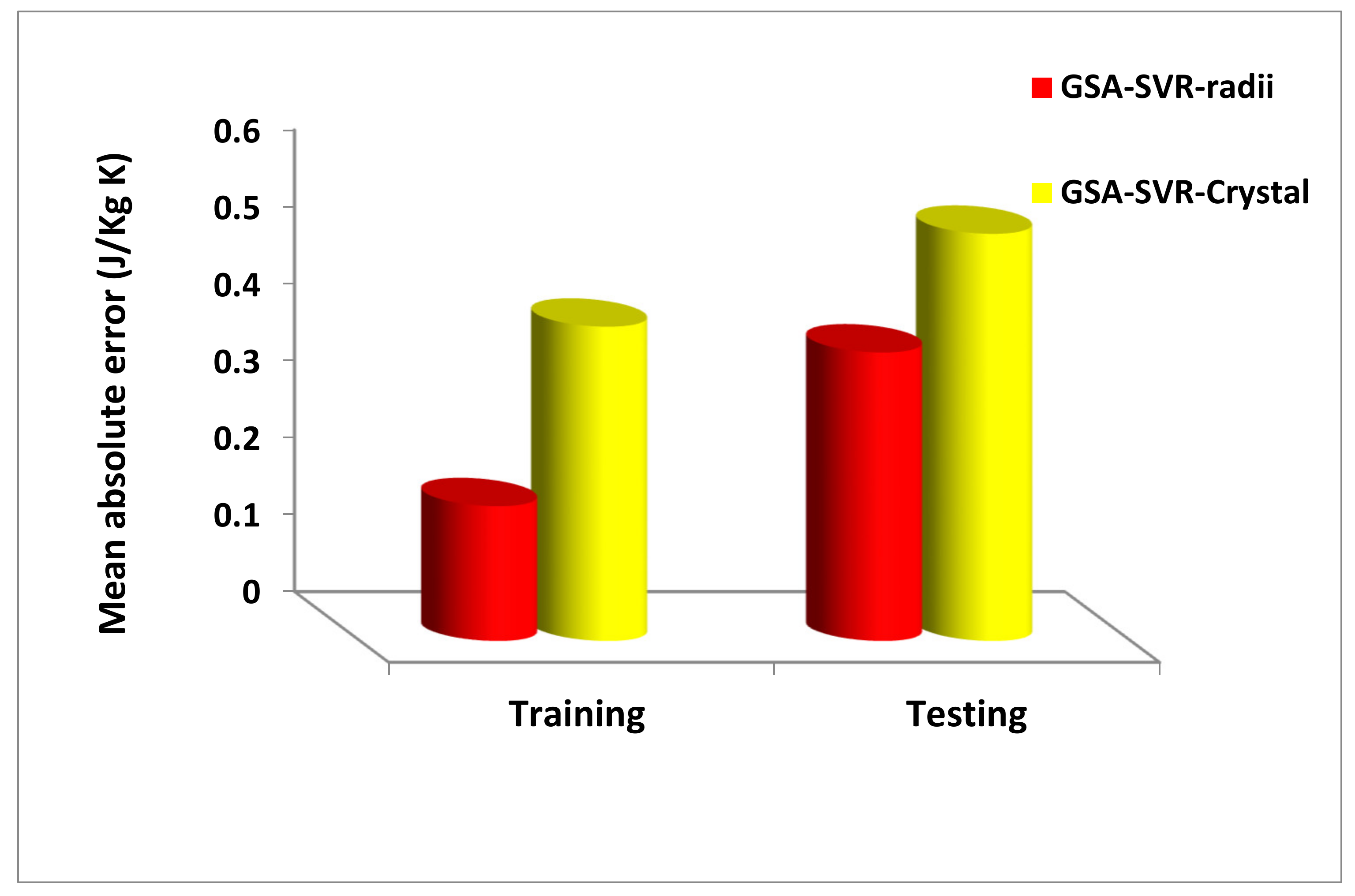


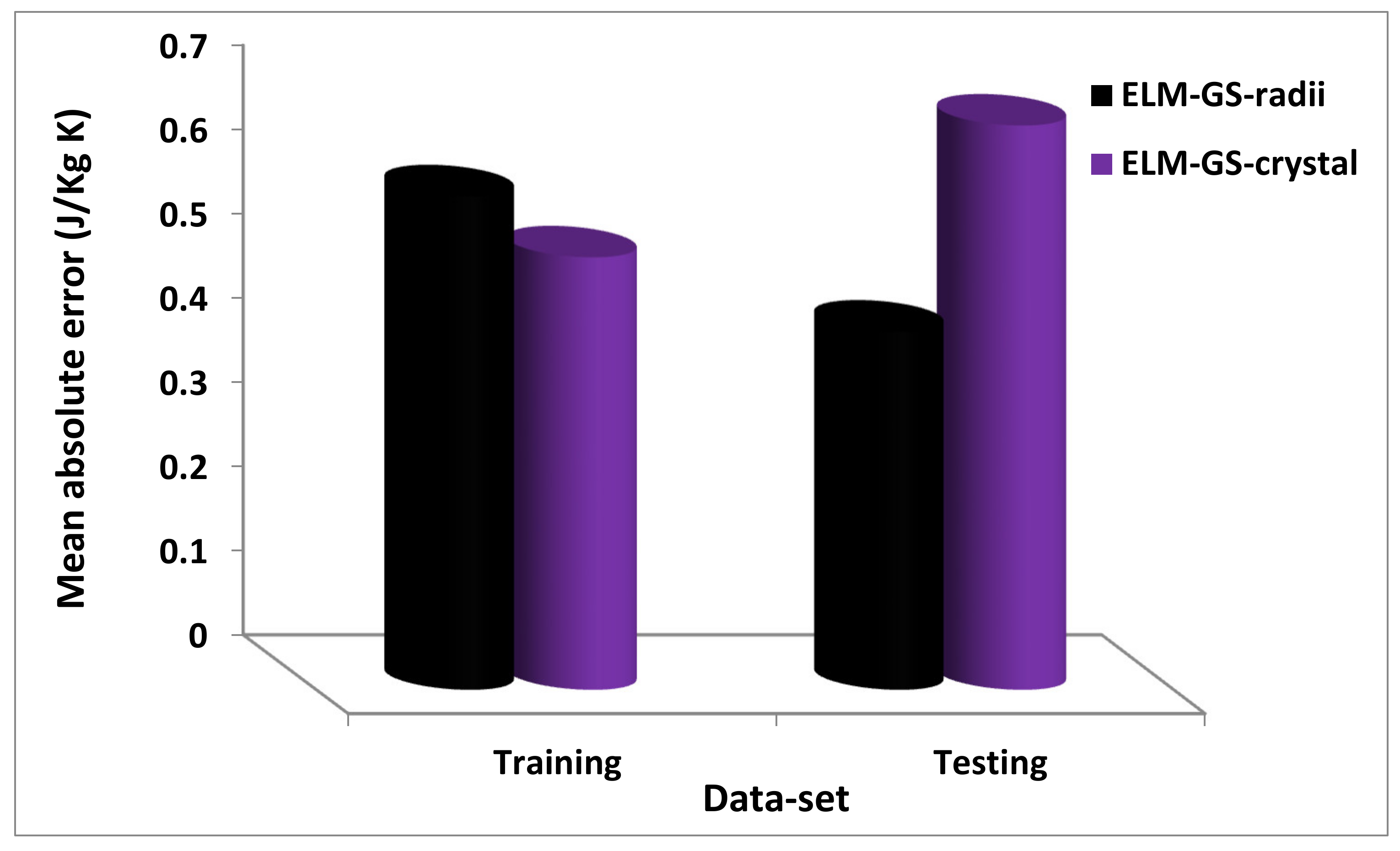


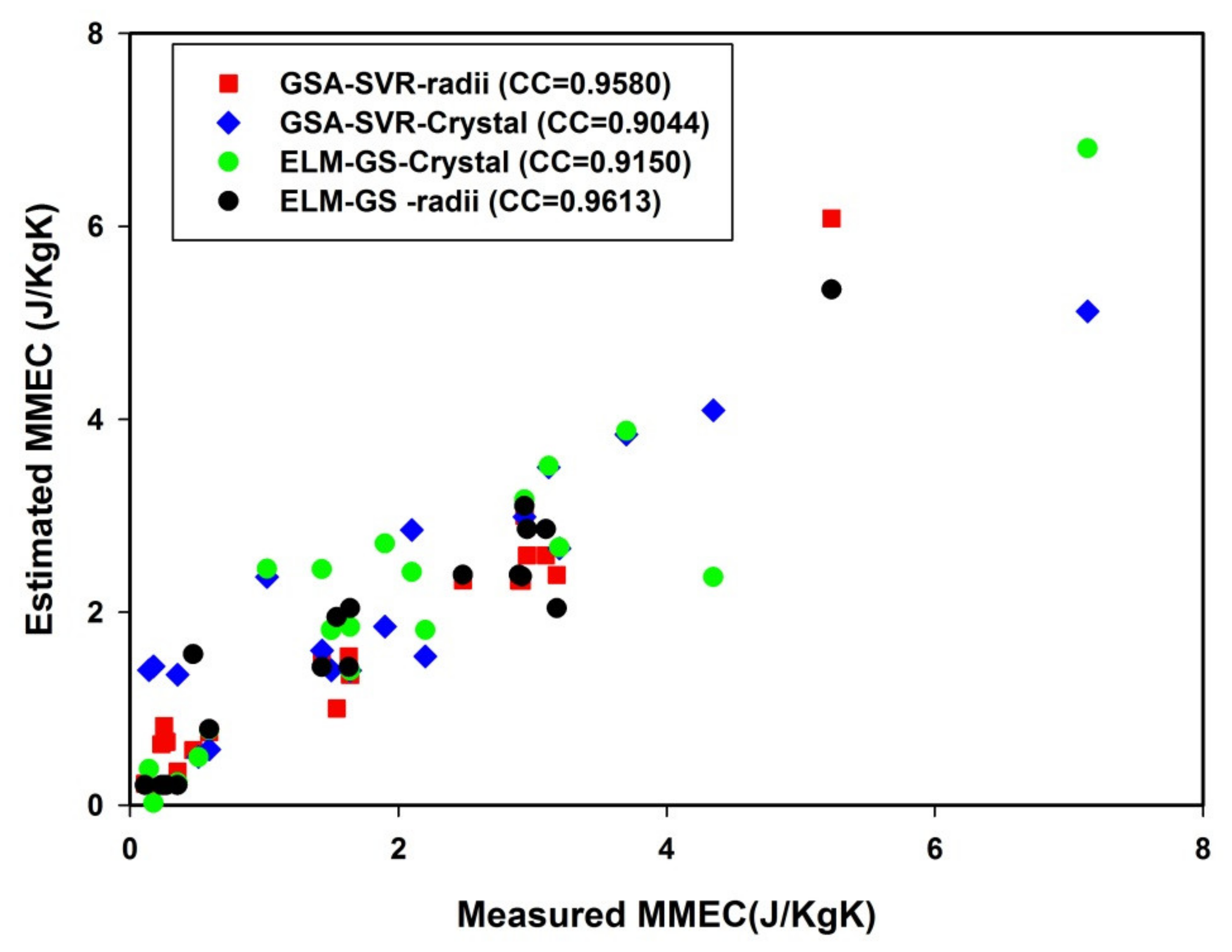

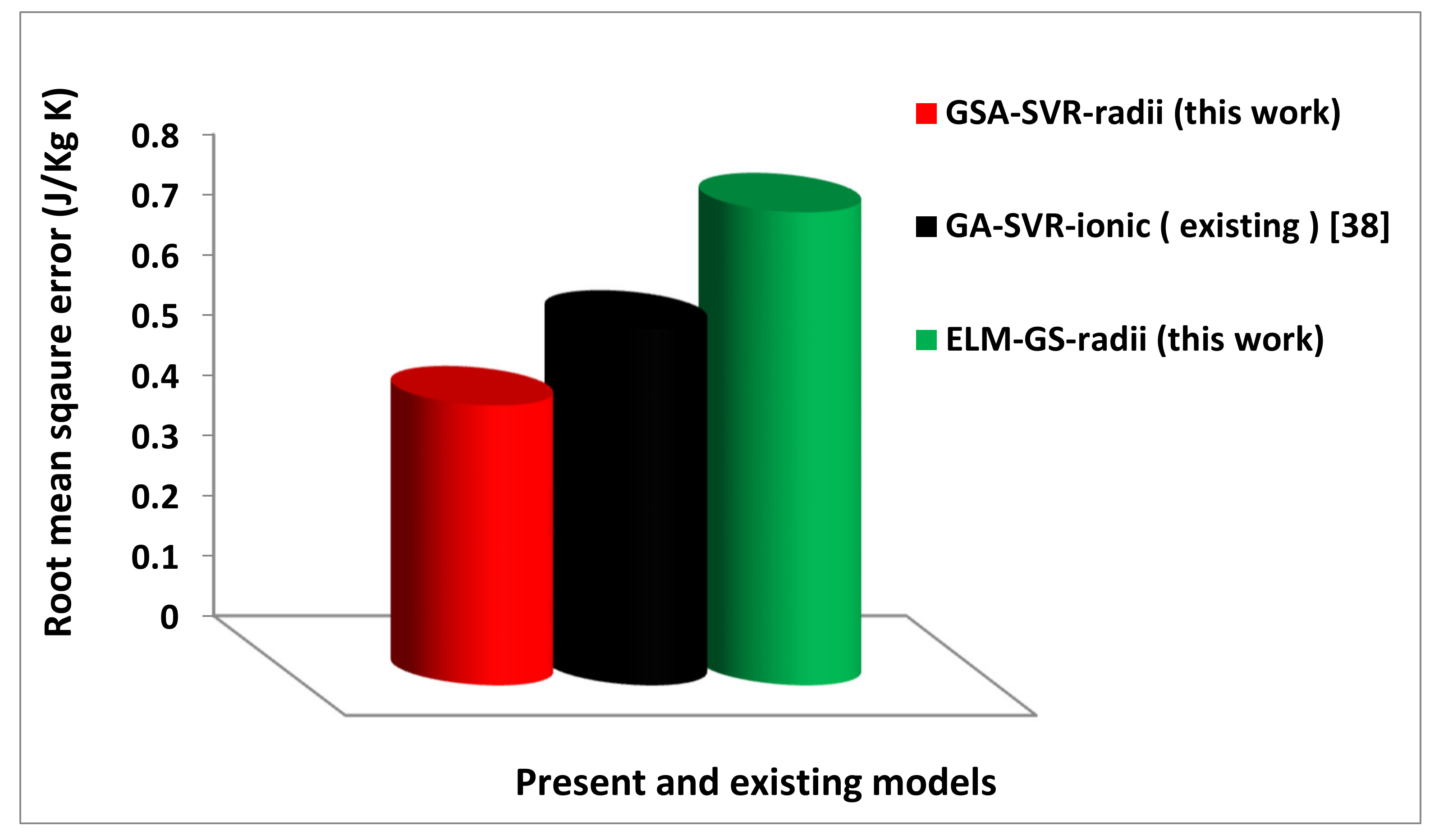
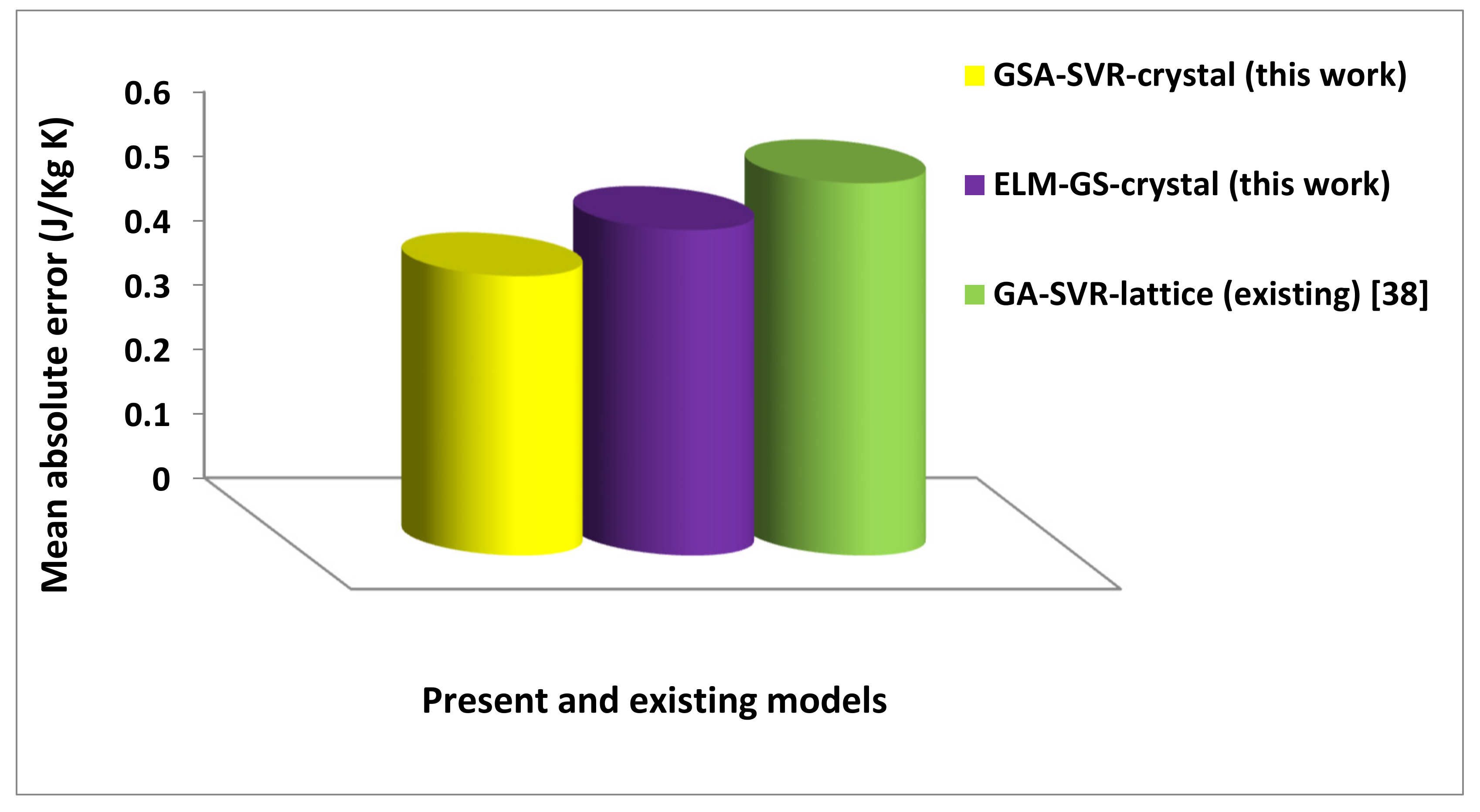

| Quantity | Minimum | Maximum | Mean | Standard Deviation | Correlation Coefficient |
|---|---|---|---|---|---|
| R(pm) | 109.8 | 143 | 115.696 | 4.652 | −0.272 |
| A(pm) | 0 | 152 | 103.83 | 51.2 | 0.389 |
| B(pm) | 0 | 152 | 79.92 | 66.139 | 0.334 |
| C(pm) | 0 | 100 | 23.07 | 38.523 | 0.14 |
| a | 0 | 0.45 | 0.162 | 0.126 | 0.261 |
| b | 0 | 0.45 | 0.161 | 0.169 | 0.441 |
| c | 0 | 0.3 | 0.029 | 0.048 | −0.189 |
| Distortion along a-axis | 5.429 | 5.553 | 5.488 | 0.033 | −0.557 |
| Distortion along b-axis | 5.438 | 13.467 | 6.483 | 1.307 | 0.102 |
| Distortion along c-axis | 5.419 | 359.95 | 12.036 | 35.311 | 0.105 |
| Applied field (T) | 0.05 | 6 | 3.483 | 1.758 | 0.583 |
| MMEC | 0.003 | 7.14 | 2.117 | 1.567 |
| GSA-SVR-Radii | GSA-SVR-Crystal | ELM-GS-Radii | ELM-GS-Crystal | |
|---|---|---|---|---|
| Penalty factor | 944.3013 | 592.9928 | ---- | --- |
| Epsilon | 0.1003 | 0.3758 | ---- | --- |
| Kernel option | 0.8198 | 0.2516 | ----- | ---- |
| Number in the population | 70 | 30 | ---- | --- |
| Activation function | --- | --- | Hardlim | Sin |
| Number of hidden nodes | --- | --- | 58 | 24 |
| Parameters | GSA-SVR-Radii | GSA-SVR-Crystal | ELM-GS-Radii | ELM-GS-Crystal | ||||
|---|---|---|---|---|---|---|---|---|
| Training Testing | Training Testing | Training Testing | Training Testing | |||||
| CC | 0.9545 | 0.958 | 0.9317 | 0.9044 | 0.83777 | 0.961358 | 0.88462 | 0.914984 |
| RMSE (J/Kg K) | 0.4655 | 0.462 | 0.577 | 0.767 | 0.85233 | 0.285445 | 0.715575 | 0.46994 |
| MAE (J/Kg K) | 0.1766 | 0.376 | 0.4094 | 0.5299 | 0.586574 | 0.426137 | 0.51419 | 0.670479 |
| GA-SVR_Ionic (Existing) [38] | GA-SVR-Lattice (Existing) [38] | GSA-SVR-Radii (This Work) | GSA-SVR-Crystal (This Work) | ELM-GS-Radii (This Work) | ELM-GS-Crystal (This Work) | |
|---|---|---|---|---|---|---|
| MAE (J/Kg K) | 0.304311 | 0.578056 | 0.216517 | 0.433503 | 0.526348 | 0.50534 |
| RMSE (J/Kg K) | 0.590673 | 0.890676 | 0.464783 | 0.619666 | 0.785806 | 0.706786 |
| Doped Manganite-Based Compounds | Measured MMEC (J/KgK) | Estimated MMEC Using GSA-SVR-Crystal (J/KgK) | Absolute Error |
|---|---|---|---|
| La0.7Ca0.25Sr0.05MnO3 | 1.65 [73] | 1.5601 | 0.0899 |
| La0.67Ca0.13 Ba0.2Mn0.9Co 0.1O3 | 1.93 [74] | 1.5141 | 0.4159 |
| La0.6Bi0.1Sr0.3Mn0.9Cu 0.1O3 | 3.39 [75] | 3.9562 | 0.5662 |
| La0.8Na0.2Mn0.94Ni 0.06O3 | 3.70 [76] | 4.1572 | 0.4572 |
| La0.065Nd0.05Ba0.3Mn0.85Cr0.15O3 | 3.55 [77] | 3.1356 | 0.4144 |
| Pr0.6Ca 0.1Sr 0.3MnO3 | 3.64 [70] | 3.8108 | 0.1708 |
| Pr0.6Ca 0.1Sr 0.3Mn0.975 Fe0.025O3 | 3.53 [70] | 3.9058 | 0.3758 |
| Pr0.6Ca 0.1Sr 0.3Mn0.95 Fe0.05O3 | 3.7 [70] | 3.845 | 0.145 |
| Pr0.6Ca 0.1Sr 0.3Mn0.925 Fe0.075O3 | 3.12 [70] | 3.5018 | 0.3818 |
© 2020 by the authors. Licensee MDPI, Basel, Switzerland. This article is an open access article distributed under the terms and conditions of the Creative Commons Attribution (CC BY) license (http://creativecommons.org/licenses/by/4.0/).
Share and Cite
Shamsah, S.M.I.; Owolabi, T.O. Modeling the Maximum Magnetic Entropy Change of Doped Manganite Using a Grid Search-Based Extreme Learning Machine and Hybrid Gravitational Search-Based Support Vector Regression. Crystals 2020, 10, 310. https://doi.org/10.3390/cryst10040310
Shamsah SMI, Owolabi TO. Modeling the Maximum Magnetic Entropy Change of Doped Manganite Using a Grid Search-Based Extreme Learning Machine and Hybrid Gravitational Search-Based Support Vector Regression. Crystals. 2020; 10(4):310. https://doi.org/10.3390/cryst10040310
Chicago/Turabian StyleShamsah, Sami M. Ibn, and Taoreed O. Owolabi. 2020. "Modeling the Maximum Magnetic Entropy Change of Doped Manganite Using a Grid Search-Based Extreme Learning Machine and Hybrid Gravitational Search-Based Support Vector Regression" Crystals 10, no. 4: 310. https://doi.org/10.3390/cryst10040310
APA StyleShamsah, S. M. I., & Owolabi, T. O. (2020). Modeling the Maximum Magnetic Entropy Change of Doped Manganite Using a Grid Search-Based Extreme Learning Machine and Hybrid Gravitational Search-Based Support Vector Regression. Crystals, 10(4), 310. https://doi.org/10.3390/cryst10040310






